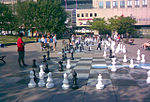Bibliothèque et Archives nationales du Québec
1967 establishments in QuebecArchives in CanadaCrown corporations of QuebecDeposit librariesLibraries established in 1967 ... and 3 more
Libraries in MontrealNational archivesNational libraries

The Bibliothèque et Archives nationales du Québec (lit. 'National Library and Archives of Quebec') or BAnQ is a Quebec government agency which manages the province's legal deposit system, national archives, and national library. Located at the Grande Bibliothèque in Montreal, the BAnQ was created by the merging of the Bibliothèque nationale du Québec and the Archives nationales du Québec in 2006. The Bibliothèque nationale du Québec had previously merged with the Grande Bibliothèque du Québec in 2002.
Excerpt from the Wikipedia article Bibliothèque et Archives nationales du Québec (License: CC BY-SA 3.0, Authors, Images).Bibliothèque et Archives nationales du Québec
Boulevard De Maisonneuve Est, Montreal Ville-Marie
Geographical coordinates (GPS) Address Phone number Website Nearby Places Show on map
Geographical coordinates (GPS)
| Latitude | Longitude |
|---|---|
| N 45.51538 ° | E -73.56234 ° |
Address
BANQ
Boulevard De Maisonneuve Est 475
H2L 5V4 Montreal, Ville-Marie
Quebec, Canada
Open on Google Maps










